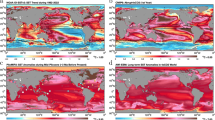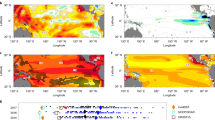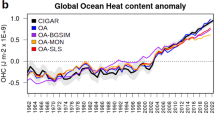This huge eruption slowed sea-level rise and ocean warming well into the following century.
Abstract
We have analysed a suite of 12 state-of-the-art climate models and show that ocean warming and sea-level rise in the twentieth century were substantially reduced by the colossal eruption in 1883 of the volcano Krakatoa in the Sunda strait, Indonesia. Volcanically induced cooling of the ocean surface penetrated into deeper layers, where it persisted for decades after the event. This remarkable effect on oceanic thermal structure is longer lasting than has previously been suspected1 and is sufficient to offset a large fraction of ocean warming and sea-level rise caused by anthropogenic influences.
Similar content being viewed by others
Main
We examined the latest series of coupled ocean–atmosphere model experiments that include time-varying external forcings (for example, changes in greenhouse gases, solar irradiance, sulphate aerosols and volcanic aerosols) for the period 1880–2000 (see supplementary information). These models differ in their physics, resolution, initialization and ocean–atmosphere coupling procedures, and have different combinations of external forcings. Uncertainties in both the applied forcings and in the model responses to them are therefore inherent in our investigation.
We compared the evolution of global ocean heat content over 1880–2000 in six models that include the effects of volcanic eruptions (V) with six that do not (see supplementary information). Observations (which are subject to uncertainties arising from incomplete space- and time-varying coverage2,3) suggest that the heat content of the upper 3,000 m of the ocean increased at a rate of 0.33 x 1022 J yr−1 over 1955–98. This is in closer agreement with the V simulations (average: 0.2 x 1022 J yr−1; with 1 s.d.: 0.16 x 1022 J yr−1) than with the simulations that do not include V (average: 0.78 x 1022 J yr−1; with 1 s.d.: 0.25 x 1022 J yr−1).
An abrupt drop in heat content in the V simulations (Fig. 1a) follows the 1883 Krakatoa eruption, augmented by much smaller eruptions in 1886 and 1888. Volcanic aerosols scatter and absorb sunlight and result in a cold ocean-surface-temperature anomaly. This is gradually subducted into deeper layers1,4, where it persists for decades (Fig. 1b). Although surface warming in the late twentieth century is apparent in all V simulations, a cold anomaly remains discernible at depth.
a, Change in global ocean heat content. Shading represents the ±1 s.d. range of simulations with (blue) and without (green) volcanic forcing, V, about the corresponding multi-simulation means (white lines). Purple shading at the top is an estimate of changes in the amount of volcanic dust in the stratosphere, a measure of the reduction in sunlight reaching the Earth's surface (arbitrary scale). b, Global ocean-temperature anomalies as a function of depth for the mean of the simulations with and without V. The inter-simulation s.d. (not shown) decreases with depth, increases with time, and is generally larger for the V simulations. (For methods, see supplementary information.)
In spite of substantial differences in model formulations and applied external forcings (and, in particular, uncertainties in volcanic forcing in the pre-satellite era5; see supplementary information), the distinction between the simulations with and without V in Fig. 1 is striking. Although solar forcing is included only in the V simulations, its effect is minimal.
An oceanic response to the 1991 Pinatubo eruption, which was comparable to Krakatoa in terms of its radiative forcing, has been identified in satellite altimetry data1. The simulated heat-content recovery after Pinatubo seems to occur much more rapidly than for Krakatoa (Fig. 1a). This disparity arises because the Pinatubo response is superimposed on a non-stationary background of large and increasing greenhouse-gas forcing. The heat-content effects of Pinatubo and other eruptions in the late twentieth century are offset by the observed warming of the upper ocean, which is primarily due to anthropogenic influences6.
Ocean warming (or cooling) contributes to sea-level changes by thermal expansion (or contraction). Global mean thermal expansion is highly correlated with changes in heat content, and so comparisons of thermal expansion between the V and non-V simulations look much like Fig. 1a. Increases in thermal expansion at the end of the twentieth century (relative to 1882, the year before Krakatoa) are appreciably less for simulations with V (average: 1.7 cm; with 1 s.d.: 1.8 cm) than for the simulations without V (average: 6.3 cm; with 1 s.d.: 2.2 cm).
In model simulations, Krakatoa has long-lasting effects, offsetting a large fraction of the changes in ocean heat content and thermal expansion caused by twentieth-century anthropogenic influences. These results are robust to current uncertainties in climate models and in the historical forcings applied to them. Inclusion of volcanic forcing from Krakatoa (and, by implication, from even earlier eruptions) is important for a reliable simulation of historical increases in ocean heat content and sea-level change due to thermal expansion.
References
Church, J. A., White, N. J. & Arblaster, J. M. Nature 438, 74–77 (2005).
Levitus, S., Antonov, J. I. & Boyer, T. P. Geophys. Res. Lett. 32, L02604 doi:10.1029/2004GL021592 (2005).
AchutaRao, K. M. et al. J. Geophys. Res. (in the press).
Delworth, T. L., Ramaswamy, V. & Stenchikov, G. L. Geophys. Res. Lett. 32, L24709 (2005).
Robock, A. Rev. Geophys. 38, 191–219 (2000).
Barnett, T. P. et al. Science 309, 284–287 (2005).
Author information
Authors and Affiliations
Corresponding author
Ethics declarations
Competing interests
The authors declare no competing financial interests.
Supplementary information
Supplementary information
(DOC 70 kb)
Rights and permissions
About this article
Cite this article
Gleckler, P., Wigley, T., Santer, B. et al. Krakatoa's signature persists in the ocean. Nature 439, 675 (2006). https://doi.org/10.1038/439675a
Published:
Issue Date:
DOI: https://doi.org/10.1038/439675a
This article is cited by
-
A Review of El Niño Southern Oscillation Linkage to Strong Volcanic Eruptions and Post-Volcanic Winter Warming
Earth Systems and Environment (2023)
-
Southern Hemisphere continental temperature responses to major volcanic eruptions since 1883 in CMIP5 models
Theoretical and Applied Climatology (2022)
-
Ocean Sensitivity to Periodic and Constant Volcanism
Scientific Reports (2020)
-
Attribution of ocean temperature change to anthropogenic and natural forcings using the temporal, vertical and geographical structure
Climate Dynamics (2019)
-
Interannual Weakening of the Tropical Pacific Walker Circulation Due to Strong Tropical Volcanism
Advances in Atmospheric Sciences (2018)
Comments
By submitting a comment you agree to abide by our Terms and Community Guidelines. If you find something abusive or that does not comply with our terms or guidelines please flag it as inappropriate.




